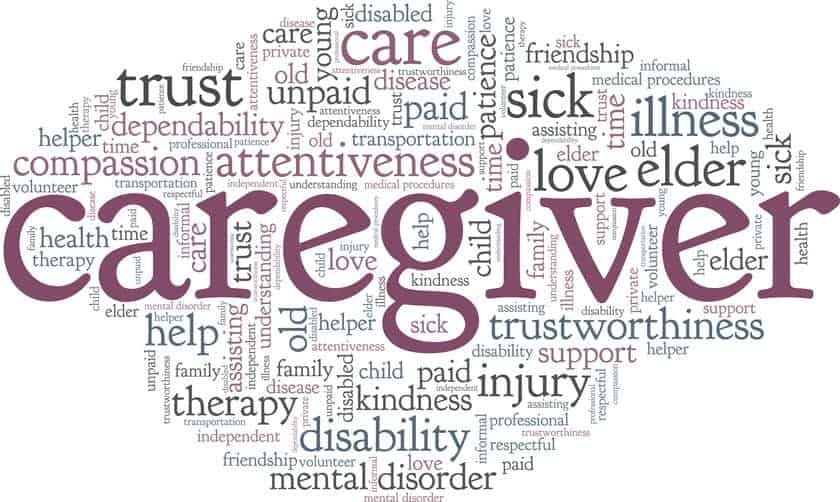Being a caregiver can be a rewarding undertaking. Taking care of another person is sometimes a choice and other times put upon us due to circumstances. Either way, it can be a tough job that is often times emotionally taxing and physically demanding. But it’s also an opportunity to make another person’s situation better.
When in the role of caregiver, we tend to put the needs of the one we are caring for ahead of our own. This is kind-hearted human nature, our basic goodness. However, it’s important to remember the oxygen mask instruction on airplanes. We need to put our own oxygen mask on before assisting another with theirs. This instruction can also be a metaphor for our own caregiving situation. As we care for others, we also need to learn the important skill of being compassionate and caring toward ourselves in the process.

Caregiver burnout is a reality for many people. An abundance of studies have been conducted on people who experience heightened stress levels as they care for others, whether it be in a personal or professional capacity. When caring for someone or several people, caregivers often feel like they are doing a juggling act that is difficult to manage. And many people who are caring for others often neglect themselves, which contributes to burnout. It is vital for people who take care of others to adopt a practice of self-compassion.

What is Self-Compassion?
Let’s begin by exploring what self-compassion is and what it is not. Self-compassion is compassion turned inward toward the self. The word compassion has two parts: passion which means “to suffer,” and com which means “with.” So compassion means “to suffer with.” It doesn’t mean to pity or feel sorry for yourself. It means to empathize and understand what someone is going through.
When we engage in self-compassion, we are actually befriending ourselves. We are taking time to acknowledge what we are experiencing and how it is making us feel. This does not mean wallowing in self-pity, which generates a negative type of energy. Self-compassion generates a positive type of energy of understanding and empathy.

Consider a time when a friend was going through a difficult situation. Were you there for them to lend an ear or a word of understanding or comfort? Self-compassion is treating ourselves the way we treat our friends. If we treated our friends like we treated ourselves, we wouldn’t have many friends. Our self-talk can be highly judgmental and even vicious at times. This negative self-talk also can drain our energy and resources. It’s important to recognize when we’re being self-critical and challenge our negative thoughts. We need to learn to be kinder to ourselves, as we are toward our friends.
5 Steps to Becoming More Self-Compassionate
Step 1
Acknowledge yourself as a human being.
Acknowledging yourself as a human being means understanding that we are not perfect and that everyone experiences difficulties in their lives. Being human also means that we make mistakes. What is important is learning from our mistakes rather than ruminating over them and belittling ourselves.

When caring for others, we can often feel like we aren’t doing enough. If you’ve ever had someone simply sit and listen to you or be present to you when you were needing care or support, you know the comfort from that experience. Your presence and willingness to offer an ear or shoulder are enough!
Step 2
Be aware of any critical self-talk.
When we are in the caregiver role, we may tend to be critical of ourselves. Our negative self-talk can have a significant impact on our ability to effectively care for others. This self-criticism may make it more difficult for us to see ourselves as supportive and helpful. Negative self-talk hinders us from taking care of ourselves and may lead to self-neglect. It can be a downward spiral that leads to feelings of worthlessness and burnout.
If left unchecked, judgmental self-talk can cause more problems than we think. It can lead to mental stress and negative emotions, making it hard to function at our best. As we become more aware of the self-berating voice in our head, we also need to pay attention to the tone of that voice. Harsh tones of voice are not helpful and can actually make us feel worse about ourselves. To overcome this issue, it is crucial to notice any over-critical dialogue we have going on in our mind. This awareness alone may stop negative self-talk in its tracks, but we also may need to find counter-messages to overcome our negative thinking.

Some counter-messages may include phrases such as, “I am being helpful.” Or “I am making a difference.” There are several breath and heart-based techniques that can also help decrease the negative self-talk. Simply focusing on our breath and imagining it flowing in and out of our heart can remind us of our inner desire to be of service. It can help us become more centered or grounded and take us out of our mental chatter.
The more we are aware of our inner dialogue, the more control we will have over the messages we say to ourselves. It’s important that we remember to use a kind and compassionate tone with any self-talk, especially when acknowledging our mistakes!
Step 3
Use soothing touch.
Physical touch is one of our basic needs as human beings. When someone touches us in a soothing way, we feel empathy and support. Soothing touch can have a significant impact on our emotions and state of mind. If we can adopt a means of soothing self-touch, we may find the benefits surprising.

One form of soothing self-touch is doing hand massage on yourself. This is a simple practice to adopt and you don’t need any training. Just gently massage the palms and fingers. When you start feeling overwhelmed, a gentle hand massage can provide a message to the body and the mind that you are able to take care of your own needs at any moment.
Another form of soothing self-touch can be simply placing your hands over your heart. Many people have found great benefits in doing this simple practice. Try applying different amounts of pressure and notice which amount works best for you.

Once you can identify which type of soothing touch is most beneficial, you can start using it to generate self-compassion at any time of day or night. Our bodies respond positively to comfort, even light touch, which fosters feelings of gentle tenderness toward ourselves.
Step 4
Pretend it’s your friend who is dealing with the issue.
Sometimes, being a caregiver can generate feelings of frustration and resentment. For example, you may notice that you are frustrated with others who are not pitching in and doing their part to offer care or support for the person in need. And you begin to harbor resentment toward them for their lack of willingness to help.
Here’s an exercise that may help you find a new way of addressing this problem.
Begin by identifying a very dear friend; someone you genuinely care about and understand well.
Next, imagine that this particular friend is experiencing this problem instead of you.
Take some time to imagine what words of advice or support you would offer your friend. You may even want to write a letter or a note to this friend offering support and comfort.

Once you have finished writing the letter, cross out their name and put your own name in place of theirs.
Read the letter to yourself and see if you notice any new perspectives or ideas about how to manage this situation.
It’s possible that this exercise brings you some relief from the frustration or resentment. If you notice any difference, thank yourself for being open to doing the exercise. Take comfort in your own words of support.
If you are able to notice any shift in perspective, make a mental note of this and take steps to act on what you learned.
Step 5
Set an intention of being kind to yourself.
Treating yourself kindly is not only the right thing to do but also has enormous benefits for your mental and emotional health. Whether you’re dealing with sadness, anger, or burnout, taking care of yourself is essential. Committing to self-compassion practices daily can help you regulate these emotions and improve your overall sense of well-being. Take 1 minute every day to set an intention of being kind to yourself.

Furthermore, by consciously choosing to be kinder towards yourself every day, you will be more inclined to extend that kindness toward others!
Conclusion
Self-compassion is a powerful form of self-care. When we take care of our inner self, we can manage through the stressors of life in a more balanced way.

As a caregiver, you may experience times of emotional depletion or burnout, and that is why it’s essential to care for yourself with compassion. Self-compassion can be very empowering and life-giving. It can help you deal with the challenges and frustrations that arise as you care for others.
By following the 5 Steps for self-compassion practice described here, you can develop a strong emotional foundation that will help you care for yourself in the best possible way. Remember, self-compassion is a key strategy to maintaining your emotional/mental health and well-being, enhancing your ability to take care of others.

